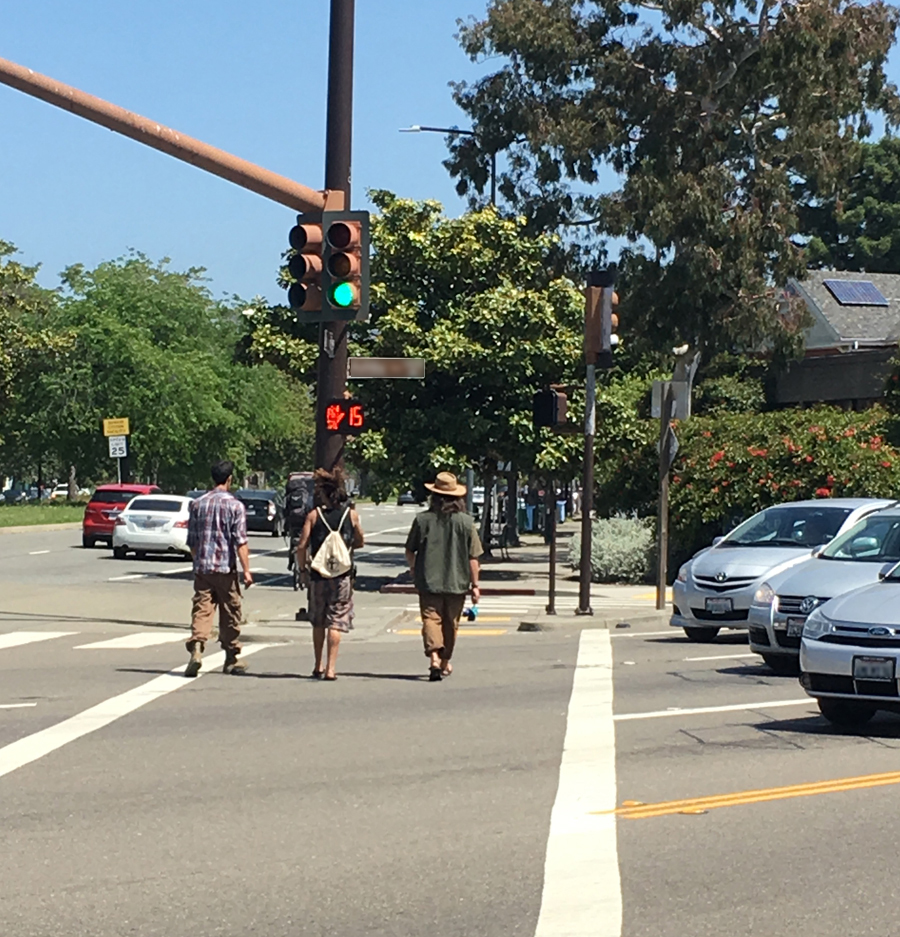Two bills got a hearing at yesterday's Assembly Transportation Committee. One, to clarify rules about pedestrian countdown signals, passed on to the Assembly floor. The second one, which would allow bicycle riders to roll through stop signs when safe, was put off for the moment. It was discussed, but no vote was taken.
The first bill, A.B. 390, would allow “a pedestrian facing a 'countdown' signal to proceed across the roadway in the direction of the signal if there is sufficient time left on the countdown to reasonably complete the crossing safely.” The bill's co-author, Miguel Santiago (D-Los Angeles), said that in Los Angeles, 16,000 tickets had been written to pedestrians “due to a misunderstanding of the law.”
That is, a pedestrian sees a countdown as permission to cross if there is time, but the police have–inconsistently— applied existing outdated law, which forbids beginning to cross when a flashing or steady hand is showing. That rule was written before countdown signals became common. A representative of the city of Los Angeles praised the bill's clarification of the law and said it would “enhance pedestrian safety.”
Several groups of disability rights advocates at the hearing opposed the bill, citing “unintentional consequences” and asking that the issue instead be sent to the California Traffic Control Devices Committee, which is charged with developing consistent traffic signals.
Committee Chair Jim Frazier (D-Oakley) told the author that he was “struggling” with the bill, and that he worried that it would encourage pedestrians to dart across an intersection. Despite his objection, everyone else on the committee voted yes, and it passed to the Assembly floor on a 13-1 vote.
The other bill heard yesterday, A.B. 1103, is the so-called “bike yield” or “Idaho stop” bill from Assemblymember Jay Obernolte (R-Hesperia) that would make it legal for bicycle riders to slow down and then proceed through a stop sign without stopping if it is safe to do so.
Obernolte began by saying that he was going to take the chair's advice and convert it to a "two-year” bill, which means postponing a vote until next year's legislative session.
But since everyone was ready to discuss it, they went ahead with the hearing. A.B. 1103 elicits strong and emotional reactions, as exhibited in the comments section of last week's Streetsblog's story. Many people hear what the bill is about and jump immediately to thinking it would exempt bike riders from stop signs or even red lights.
It doesn't. It is also essentially an acknowledgement of what is already a common and safely applied practice among many bicyclists--but saying even that much gets people arguing that wide disobedience of a law is not a reason to change it. Perhaps it's not, in general. Nevertheless Assemblymember Obernolte made a strong argument for nuance on that point. “It is our obligation to change the law when it doesn't make sense,” he said, “lest we erode trust in all laws.”
But the main reason to pass this bill, he said, is safety. Jason Meggs, who testified in support of A.B. 1103, has done extensive research on the “Idaho stop law,” so-called because it has been legal since 1982 in Idaho for bikes to yield, rather than stop completely, at stop signs. “There is a great deal of evidence that it can increase safety,” said Meggs, “and the reasons are complex and counterintuitive.”
Some of those reasons were explained in the earlier SBCA article. Meggs also mentioned:
- A bike rider can clear an intersection faster when she retains some momentum, rather than starting up from a dead stop, thus reducing her crash risk
- A bike rider can stop faster and has a better field of view than a car driver, so sudden maneuvers to avoid a crash are easier—which especially applies to moving bikes, however slowly they are moving
- Bike riders “have a tremendous incentive to avoid injury,” being extremely vulnerable to bodily harm in a way that car drivers are not
In addition, said Meggs, the stop sign was invented for cars, not for bikes, and “it's not warranted to be used as a traffic calming device,” a common use for stop signs on quiet residential streets. In California, he said, motor vehicle laws weren't applied to bicycles until 1963. “There have never been any safety studies done for applying stop signs to bicycles,” he said.
Other support came from Bill Burton, a Trinity County supervisor who co-authored the three-foot passing bill, and from the California Bicycle Coalition. “Fixing our streets to encourage people to ride bikes will take decades,” said Jeanie Ward-Waller, CalBikes policy director. “This small change can encourage more biking now.”
Disability rights activists present at the hearing, many of them blind and representing different advocacy groups, were flat-out opposed to the bill, but many of their comments applied to problems they had with bikes, period—for example, hearing them approach, or other issues with bicyclist behavior. The AAA and the California Police Chiefs Association also opposed the bill, but representatives of those groups said they were willing to work with the author on a compromise.
Chair Frazier queried a representative of the California Highway Patrol, who said the CHP did not have an official position on the bill but is “concerned.” “There are no statistics on whether it's safer to not stop” at stop signs, he said. Assemblymember Catharine Baker (R-San Ramon) asked him if he would support a pilot program to test this and to gather that data. “The more information we have, the better,” he agreed.
The bipartisan interest in this bill gave the hearing a different tone than usual for bills that are of interest to bike riders. Baker in particular commended Obernolte for bringing this bill forward.
Obernolte reiterated that his main concern was safety. “If I didn't believe this would improve safety,” he said, “I wouldn't have written this bill. But it's more than just what I believe; it's about data. People object that it wouldn't be safe, but they don't show any data on that, and we have voluminous data showing this law would make it safer for everyone.”
“This bill does not change the rules on right of way,” he said. “The problem is, it's against the law to do what most bikes do. . . because of the physics of riding bikes.”
“Bikes are not cars; they have very different strengths, and very different weaknesses. To treat them the same is doing a disservice to everyone in California.”






